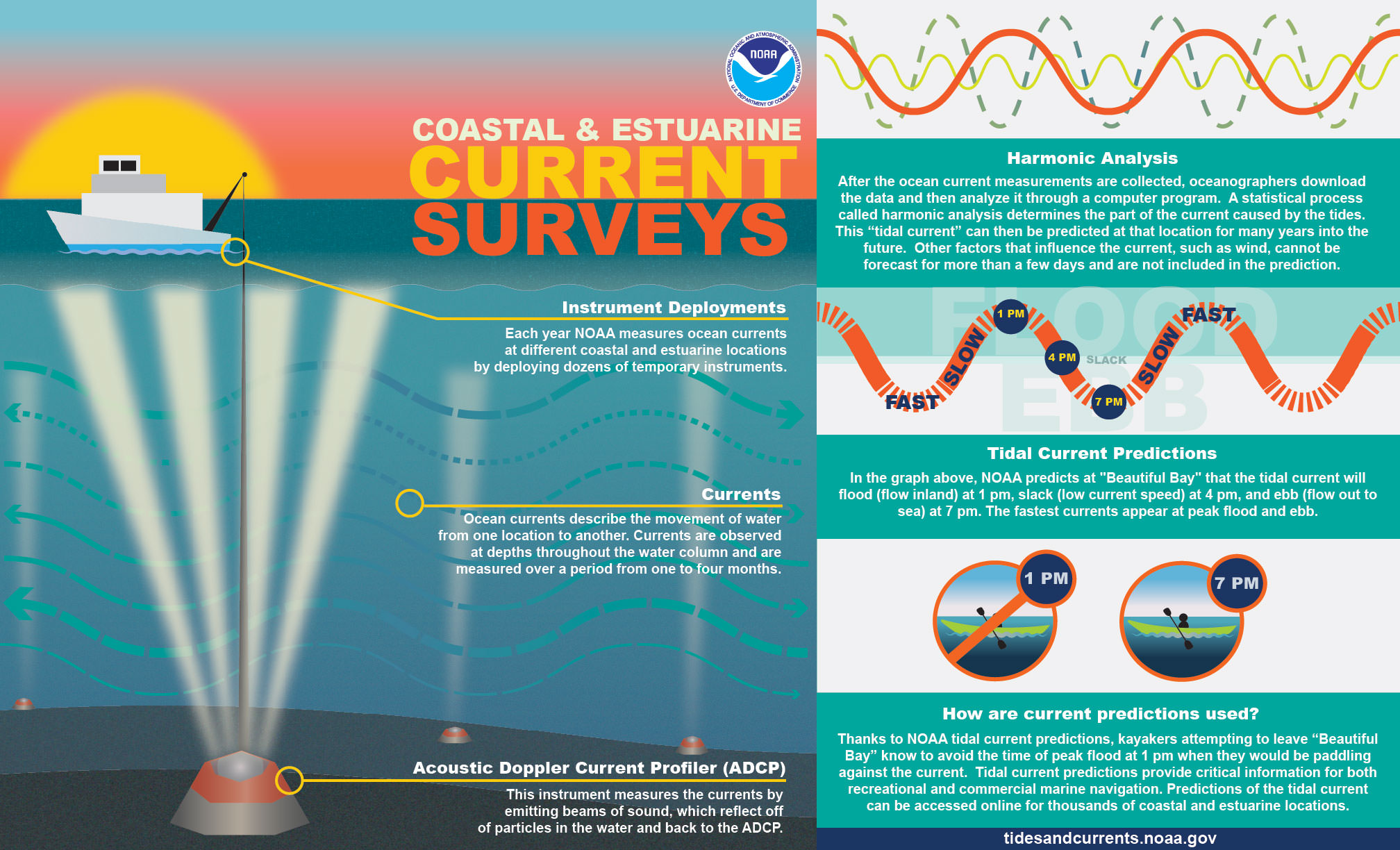What is a current survey?
A current survey is used to improve the accuracy of tidal current predictions.

The How and Why of Current Surveys
NOAA periodically conducts current surveys in areas around the nation to ensure the accuracy of tidal current predictions. Commercial and recreational mariners depend on this information for safe navigation. Download infographic | Transcript
Did you know?
An Operational Forecast System provides a nowcast and forecast (up to 48 hours) of water levels, currents, salinity, water temperatures, and winds for a given area. These systems are located in coastal waters and the Great Lakes in critical ports, harbors, and estuaries.

NOAA's Center for Operational Oceanographic Products and Services provides tidal current predictions to commercial and recreational mariners who rely on this information for safe navigation. In order to provide the most accurate predictions possible, NOAA must periodically resurvey various coastal and estuarine locations. Survey locations are selected based on mariners' navigation needs, oceanographic analyses, and the amount of time that has passed since the last survey. Given modern improvements in measurement and computing technology, these surveys greatly improve the accuracy of tidal predictions. In 2017, for example, NOAA concluded a three-year current survey of Puget Sound, Washington, to update the region's tidal current predictions. Prior to the survey, predictions were based on limited amounts of data collected in the 1930s-1960s.
To collect the data they need, NOAA scientists typically deploy Acoustic Doppler Current Profilers (ADCPs) to measure currents throughout the water column at various locations for a period of one to four months. The observations collected from the ADCPs are used to generate tidal current predictions at these locations. In addition to current measurements, NOAA often deploys salinity, temperature, oxygen, and pressure sensors at select locations to track the movement of various water masses. While the combined data is used to create better tidal prediction models, it is also used to support the creation of NOAA Operational Forecast System (OFS) hydrodynamic models. These models provide short-term forecasts of water levels, currents, water temperature, and salinity in coastal areas.
Infographic Transcript: Coastal & Estuarine Current Surveys
Instrument Deployments: Each year NOAA measures ocean currents at different coastal and estuarine locations by deploying dozens of temporary instruments.
Currents: Ocean currents describe the movement of water from one location to another. Currents are observed at depths throughout the water column and are measured over a period from one to four months.
Acoustic Doppler Current Profiler (ADCP): This instrument measures the currents by emitting beams of sound, which reflect off of particles in the water and back to the ADCP.
Harmonic Analysis: After the ocean current measurements are collected, oceanographers download the data and then analyze it through a computer program. A statistical process called harmonic analysis determines the part of the current caused by the tides. This “tidal current” can then be predicted at that location for many years into the future. Other factors that influence the current, such as wind, cannot be forecast for more than a few days and are not included in the prediction.
Tidal Current Predictions: In the graph above, NOAA predicts at "Beautiful Bay" that the tidal current will flood (flow inland) at 1 pm, slack (low current speed) at 4 pm, and ebb (flow out to sea) at 7 pm. The fastest currents appear at peak flood and ebb.
How are current predictions used? Thanks to NOAA tidal current predictions, kayakers attempting to leave “Beautiful Bay” know to avoid the time of peak flood at 1pm when they would be paddling against the current. Tidal current predictions provide critical information for both recreational and commercial marine navigation. Predictions of the tidal current can be accessed online for thousands of coastal and estuarine locations.